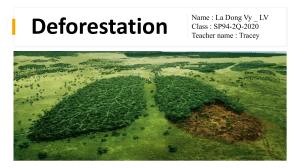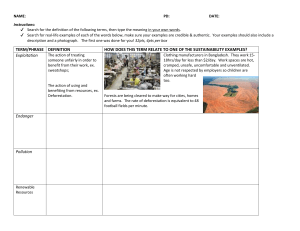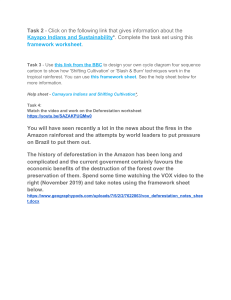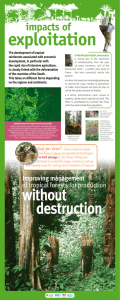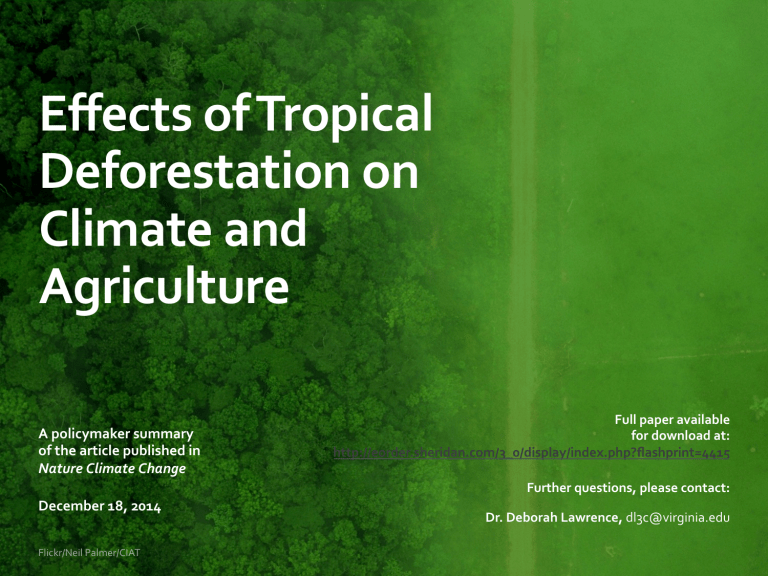
Effects of Tropical Deforestation on Climate and Agriculture A policymaker summary of the article published in Nature Climate Change Full paper available for download at: http://eorder.sheridan.com/3_0/display/index.php?flashprint=4415 Further questions, please contact: December 18, 2014 Flickr/Neil Palmer/CIAT Dr. Deborah Lawrence, dl3c@virginia.edu Key messages Deforestation contributes to global warming, which in turn creates future challenges for agriculture. A new study in Nature Climate Change provides powerful evidence that deforestation poses additional threats to food production and the climate. Deforestation creates immediate impacts on rainfall and temperature, which can occur locally and as far away as other continents. Deforestation-­‐induced climatic changes interact with global warming caused by greenhouse gas emissions, each potentially having a worsening effect on the other. Models suggest tipping points exist after which impacts will accelerate and forest loss, and therefore risks to agriculture, could become permanent. Deforestation creates new risks for agriculture… Luiz E. O. C. Aragao, “Environmental science: The rainforest’s water pump,” Nature, Sep. 5, 2012. Tropical forests move more water than any other ecosystem on land, turning soil water into moisture in the air, cooling the atmosphere above them. Deforestation causes increases in temperatures and changes in the amount and distribution of rainfall —generally creating a drier climate. These impacts can affect soil moisture, reducing yields in some areas and increasing flooding in others. …it can result in acute local impacts… Modeling low to high forest loss outside protected areas in the Amazon, one study showed that: • Pasture productivity declines by 28-­‐33%, and cattle production may cease to be viable in some areas • Soy yields drop by 25% in over half the Amazon and by 60% in a third of the area. Deforestation can also affect the duration of the wet and dry season. • In parts of the Amazon, the rainy season is delayed by two weeks due to deforestation. • Deforested areas get warmer, and the risk to agriculture is especially great when higher temperatures correspond with periods and areas of decreased rainfall. Flickr/Scott Bauer/USDA Flickr/Leonardo F. Freitas …and affect food production thousands of miles away. • A 40% clearing of the Amazon will reduce rainfall over 2000 miles away in the Rio de la Plata agricultural basin. • Complete Amazon deforestation would reduce rainfall in the US Midwest, Northwest and parts of the south during the agricultural season Temperature increases from deforestation can generate large upward-­‐moving air masses. When these hit the upper atmosphere they cause ripples, similar to a tsunami. The exact impacts are highly uncertain, but models show: • Complete deforestation of Central Africa would likely cause declines in rainfall in the Gulf of Mexico and parts of the US Midwest and Northwest and increase it on the Arabian Peninsula. Precipitation could also decline in Ukraine and southern Europe • Complete deforestation in Southeast Asia would increase rainfall in some parts and decrease rainfall in other parts of China and India Impacts of deforestation on rainfall are complex and uncertain The three major forest basins do not respond the same; deforestation in the Amazon and Central Africa have stronger impacts on warming and drying than in Southeast Asia, whose monsoon dynamic can counteract the effects. Rainfall in the tropics tends to decrease with deforestation, but can vary depending on the scale, pattern and placement of land clearing. For example: • Deforestation in a continuous block will lower rainfall more than the same amount of forest clearing in distributed patches. • Palm trees, soy crops and pasture all move water to air at different rates. Partial deforestation leads to less severe impacts, but still affects temperature and rainfall. For example, business as usual deforestation of the Amazon leads to similar reductions in rainfall in western Amazon as complete deforestation, but has less impact in the eastern Amazon. A tipping point for deforestation A TIPPING POINT At 30–50% deforestation, climate impacts could accelerate and forests could be replaced with savannahs. The study shows that tipping points may exist. For example, if deforestation reaches 30-­‐50% in the Amazon basin, climate impacts could accelerate and forests could be replaced by savannahs. In Central Africa and Southeast Asia, a sudden forest loss reduces rainfall, but gradual decline of forest cover produced a modest increase in rainfall. As the size of a deforested area increases, rainfall generally switches from a net increase to a net decrease within a given region. A much lower tipping point may exist if forest loss occurs in areas that are particularly important for the movement of atmospheric moisture. For example, small-­‐scale deforestation in coastal areas could disrupt the movement of moisture from ocean to areas further inland. Conclusions This is a rapidly evolving field. Much of what we know has only been learned in the past 10 years, but tells us that: • Tropical deforestation increases uncertainty and risks for food production due to direct physical changes that alter temperature and rainfall, both near and far from where forests are cleared. • Avoiding large-­‐scale deforestation in the tropics is therefore beneficial at both local and global scales. • Averages do not tell the whole story—equally important are changes to local climate variability, including how rainfall and temperature extremes are distributed, posing challenges for farmers that rely on predictable climates. • Adaptation is also critical as future crops will need to tolerate changing, and wider ranges of, temperature and rainfall patterns.

